Where Was The Garden Of Earthly Delights Painted
There are some paintings that make us feel good and hopeful, depicting scenes of life and transcendence. Then there are paintings that bring to life and give visual weight to our deepest, darkest fears. This is even more deep and dark when you live during times of great religious and cultural changes, periods like the Medieval and Renaissance. In this article, we explore Hieronymus Bosch's work The Garden of Earthly Delights (c. 1480 to 1505) as just one example of artwork during these times that was the opposite of what we would expect.
Table of Content
- 1 Artist Abstract: Hieronymus Bosch
- 2 The Garden of Earthly Delights by Hieronymus Bosch in Context
- 2.1 Contextual Analysis: A Brief Socio-Historical Overview
- 3 Formal Analysis: A Brief Compositional Overview
- 3.1 Subject Matter: Inside The Garden of Earthly Delights
- 3.2 Perspective and Scale
- 4 The Garden of Earthly Delights Meaning
- 5 Forever a Garden of Delight
- 6 Frequently Asked Questions
- 6.1 Who Painted The Garden of Earthly Delights?
- 6.2 What Do The Garden of Earthly Delights Panels Show?
- 6.3 Where Is The Garden of Earthly Delights Housed?
- 6.4 What Is The Garden of Earthly Delights Meaning?
Artist Abstract: Hieronymus Bosch
Originally named Jheronimus Anthonissen van Aken, who is now known as Hieronymus Bosch, was believed to be born around the 1450s in one of the capital towns of the Duchy of Brabant in the Netherlands, 's-Hertogenbosch or Den Bosch (meaning "The Forest"), which is the name he adopted at a later stage. Bosch came from an artistic family, and it is believed his father taught him how to paint and draw. Around 1480, he married Aleyt Goyaerts van den Meerveen, who was from a wealthy family.
 Posthumous portrait (detail) of Hieronymus Bosch, c. 1550 (attr. Jacques Le Boucq);Attributed to Jacques Le Boucq, Public domain, via Wikimedia Commons
Posthumous portrait (detail) of Hieronymus Bosch, c. 1550 (attr. Jacques Le Boucq);Attributed to Jacques Le Boucq, Public domain, via Wikimedia Commons
Bosch was also part of the organization called Brotherhood of Our Blessed Lady, which may have also commissioned some of his earlier artworks. Apparently, Bosch did not leave behind artistic records like notes or sketches and so there is very little concrete knowledge about him and his motives for his art.
He has been one of the famous Northern Renaissance painters of religious themes portrayed in fantastical and gothic ways, oftentimes very dark and apocalyptic in subject matter, yet executed in skillful detail.
The Garden of Earthly Delights by Hieronymus Bosch in Context
The popular Hieronymus Bosch artist was well-known as a painter when he lived and became even more popular after his death. What made him so popular as a painter though? Although his subject matter was religious with a strong figurative focus, what set him apart from others was the way he utilized the theme of religion to create fantasy worlds that we could easily say were almost like a type of Renaissance Surrealism.
He portrayed figures, animals, and objects in, dare we say, quite crazy settings, poses, and situations that all displayed moral ideas related to sin and succumbing to the temptation and desires of the flesh.
The famous, or infamous, Bosch triptych The Garden of Earthly Delights (c.1480 to 1505) is a rich and enigmatic display of the Garden of Eden, the Garden of Earthly Delights, and Hell. What makes it more unique is Bosch's attention to detail and his artistic skill in rendering these obscene micro-narratives within one macro narrative, so to say.
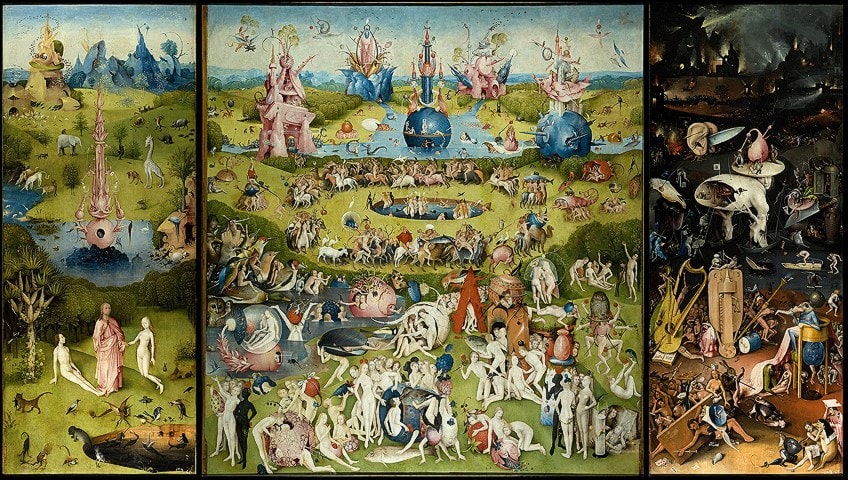 The Garden of Earthly Delights (c. 1490-1500) by Hieronymus Bosch;Hieronymus Bosch, Public domain, via Wikimedia Commons
The Garden of Earthly Delights (c. 1490-1500) by Hieronymus Bosch;Hieronymus Bosch, Public domain, via Wikimedia Commons
In The Garden of Earthly Delights analysis, we explore this painting further by first giving a brief contextual analysis, which discusses some of the political and social circumstances during the time Bosch painted. Then, we will look at a formal analysis, going deeper into the subject matter and Bosch's style of painting.
| Artist | Hieronymus Bosch |
| Date Painted | c. 1480 – 1505 |
| Medium | Oil on panel |
| Genre | Religious Painting |
| Period / Movement | Northern Renaissance |
| Dimensions | 205.5 x 384.9 centimeters |
| Series / Versions | Part of a triptych painting |
| Where Is It Housed? | Prado Museum (Museo del Prado), Madrid |
| What It Is Worth | Uncertain |
Contextual Analysis: A Brief Socio-Historical Overview
The 1400s in Europe was a time of great change. We had the Renaissance taking place in Italy and Northern parts of Europe, which marked new perspectives on life and man's place in the great cosmic scheme of things. The Humanism movement throughout this time explored new philosophical thought in many areas, including religion, science, literature, and art to name a few.
Where the Renaissance means "Rebirth", it was preceded by the Medieval era, which is often thought of as having been the "Dark Ages".
It will help us to understand some of the beliefs during the Medieval and Renaissance times because Bosch's work points to deeply ingrained religious and biblically-based perceptions, undoubtedly perceptions many would have held during the 15th century.
 Christ Child with a Walking Frame (1480) by Hieronymus Bosch ;Hieronymus Bosch, Public domain, via Wikimedia Commons
Christ Child with a Walking Frame (1480) by Hieronymus Bosch ;Hieronymus Bosch, Public domain, via Wikimedia Commons
The Catholic church was a strong force during Medieval times and aimed to convert most people, who were very commonly pagan in their beliefs. During these times there were complex systems in place to secure religious beliefs among the masses especially the beliefs in Hell and damnation. The veneration of saints was also common.
Furthermore, Medieval times had strict viewpoints when it came to notions of sexuality. The loss of man's innocence was because of the fall of Adam and Eve who gave in to temptation. This notion is of course more complex than what we are outlining here, however, the main tenets should be understood.
At the time this famous Bosch triptych was painted, these beliefs were quite prevalent in society.
It is believed this Bosch triptych, The Garden of Earthly Delights, was either commissioned by the Count Engelbrecht II of Nassau (1451 to 1504) or Henry III Nassau-Breda (1483 to 1538). The triptych could have been painted for a wedding, but other suggestions indicate it could have also been for religious purposes to provide a moral narrative showing people the consequences of temptation and sin. However, as an altarpiece, this painting may have been too obscene.
An interesting fact about Bosch's triptych is that the title, The Garden of Earthly Delights, was given to it during more modern times. Originally, this triptych was referred to as the "Strawberry Painting", which was probably due to the large number of strawberries depicted. There are generally large numbers of berries scattered around the composition.
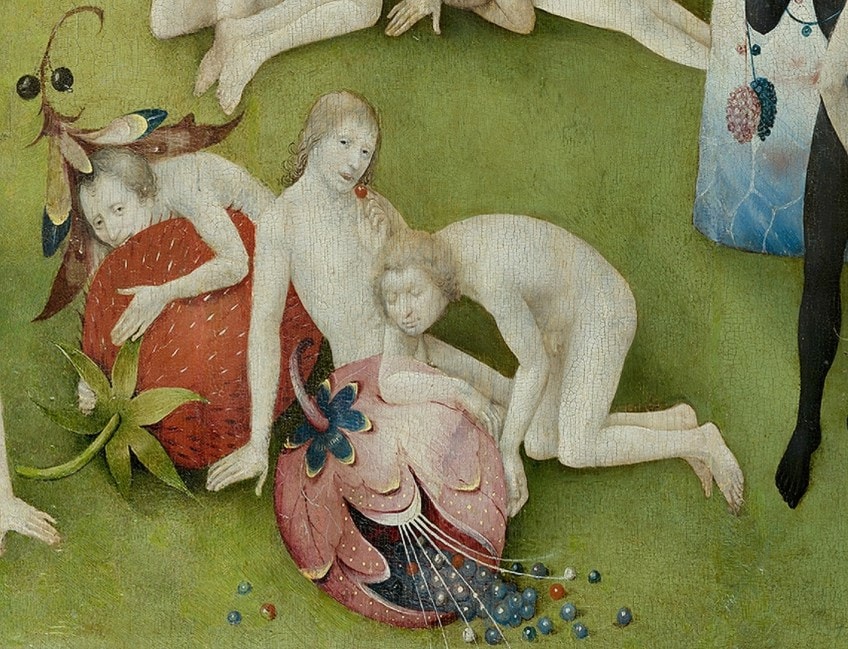 A detail of the central panel of The Garden of Earthly Delights (c. 1490-1500) by Hieronymus Bosch, depicting a man eating a strawberry, a man eating a cherry, and a man bending over a fictional fruit; Hieronymus Bosch, Public domain, via Wikimedia Commons
A detail of the central panel of The Garden of Earthly Delights (c. 1490-1500) by Hieronymus Bosch, depicting a man eating a strawberry, a man eating a cherry, and a man bending over a fictional fruit; Hieronymus Bosch, Public domain, via Wikimedia Commons
Formal Analysis: A Brief Compositional Overview
Below we go deeper into The Garden of Earthly Delights analysis, which we will do starting from left to right. The triptych itself opens into three panels with the outside wings, the front, depicting an image of the world in monochrome, also known as grisaille in French, which means "grey". This has been titled The Creation of the World (c. 1495 to 1505).
Subject Matter: Inside The Garden of Earthly Delights
When the triptych is closed, we can see the world depicted as inside a transparent orb or sphere. The bottom half seems to be water and the top half depicts the earth with thick clouds looming above the top part of the sphere. This earth orb is situated within a darkened space, the background gives it the appearance of being in space.
In the top left corner, we will notice the very small figure of God; He sits holding a book that appears to be open, possibly the Bible. There is a Latin inscription along the top part of the triptych that reads, "ipse dixit, et facta sunt: ipse mandāvit, et creata sunt". In English, it translates to "For he spake and it was done; he commanded, and it stood fast"; this is from Psalm 33 in the Bible.
 LEFT: Creation on the exterior shutters of Hieronymus Bosch's triptych The Garden of Earthly Delights (c. 1490–1510);Hieronymus Bosch, Public domain, via Wikimedia Commons | RIGHT: A close-up of God on the upper right-hand corner of the exterior shutters of Hieronymus Bosch's The Garden of Earthly Delights (c. 1490-1510);
LEFT: Creation on the exterior shutters of Hieronymus Bosch's triptych The Garden of Earthly Delights (c. 1490–1510);Hieronymus Bosch, Public domain, via Wikimedia Commons | RIGHT: A close-up of God on the upper right-hand corner of the exterior shutters of Hieronymus Bosch's The Garden of Earthly Delights (c. 1490-1510);
Hieronymus Bosch, Public domain, via Wikimedia Commons
This image is reported to depict the Third Day of Creation. Some scholarly sources suggest it is also believed to depict the flood because it appears to be mostly water and further suggests that if this frontal part is viewed as the last image of the painting, then it will have a different meaning.
This will then focus on how the Flood wiped everything and everyone away to start the world again – especially after the scenes we see inside this Bosch triptych. However, the Latin inscription is very suggestive of the creation of the world and not the destruction of it.
Let us now open the triptych up and start our journey.
Left Panel – Garden of Eden
Bosch's triptych opens into three panels, starting when the left panel is the Garden of Eden scene. We see a vast landscape of blues and greens. In the foreground there are three figures, this is Adam, sitting on the grass with his legs outstretched, Eve, half-kneeling on the small embankment opposite him, and God standing in between the two holding on to Eve's right wrist (our left) with his left hand (our right).
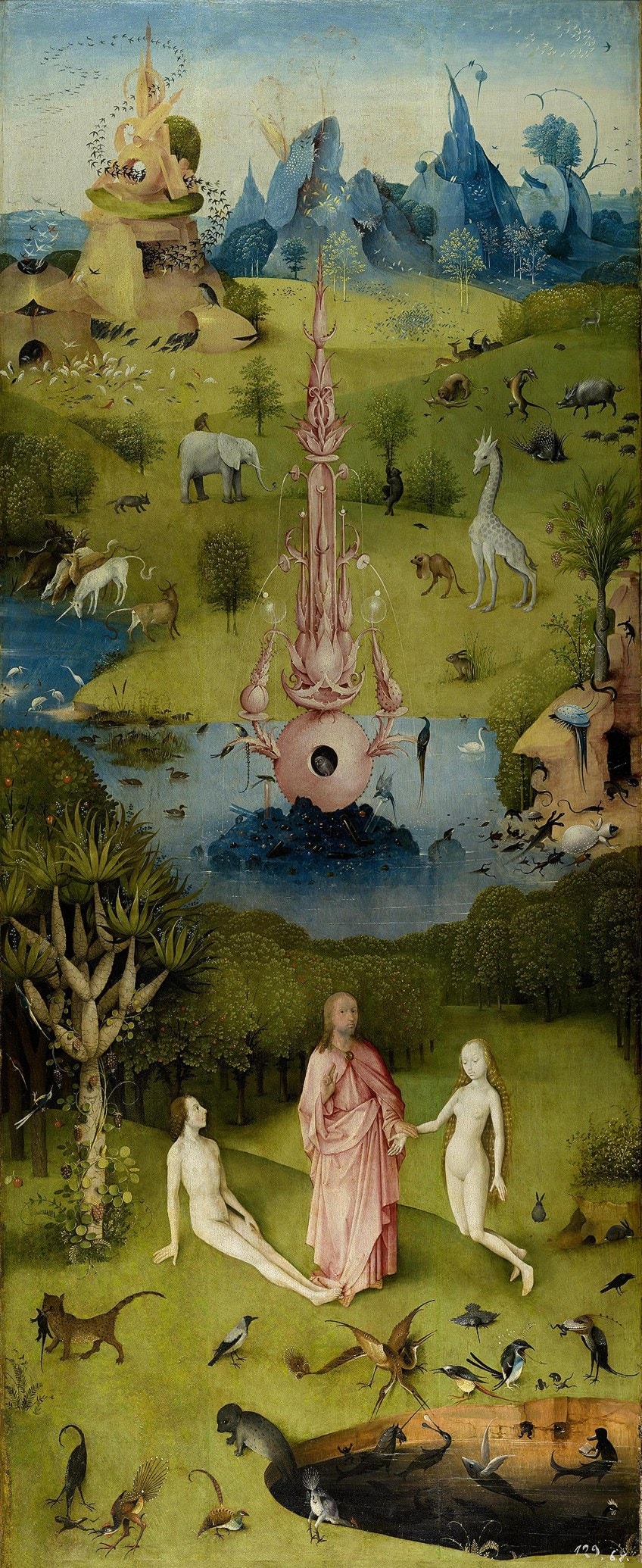 The inner left wing of The Garden of Earthly Delights (Paradise) by Hieronymus Bosc h, c. 1490-1510;Hieronymus Bosch, Public domain, via Wikimedia Commons
The inner left wing of The Garden of Earthly Delights (Paradise) by Hieronymus Bosc h, c. 1490-1510;Hieronymus Bosch, Public domain, via Wikimedia Commons
God is in the process of presenting Eve to her male counterpart, Adam. Notice how Adam stares at Eve. God's right hand is held up in the sign of Benediction, which is a gesture of blessing and a sign commonly associated with Jesus Christ. Could this figure be Jesus Christ, even though the creation of Adam and Even was before Christ's time?
In the bottom right corner in the foreground is a small and dark pond of water with an assortment of strange creatures coming out of it. Some are drinking from the water, others are in the water, and some are scattering along going about their business.
 A detail of the inner left wing of The Garden of Earthly Delights (Paradise) by Hieronymus Bosc h, c. 1490-1510;Hieronymus Bosch, Public domain, via Wikimedia Commons
A detail of the inner left wing of The Garden of Earthly Delights (Paradise) by Hieronymus Bosc h, c. 1490-1510;Hieronymus Bosch, Public domain, via Wikimedia Commons
This is where things get weird in Bosch's triptych.
There is a fish with wings, a sort of platypus creature appearing to read a book in the water, a dragon-like animal swimming, a black seahorse-type fish with a unicorn-like horn near the edge in the water, and various birds and frogs jumping around. On the land, there is a feline animal with its prey dangling from its mouth.
This is only at the forefront of the first panel. We find more oddities when we look further ahead to the middle ground, which has a large lake with a towering pink structure atop what appears to be a small mound of crystally rock, almost as if it fell from the sky onto it.
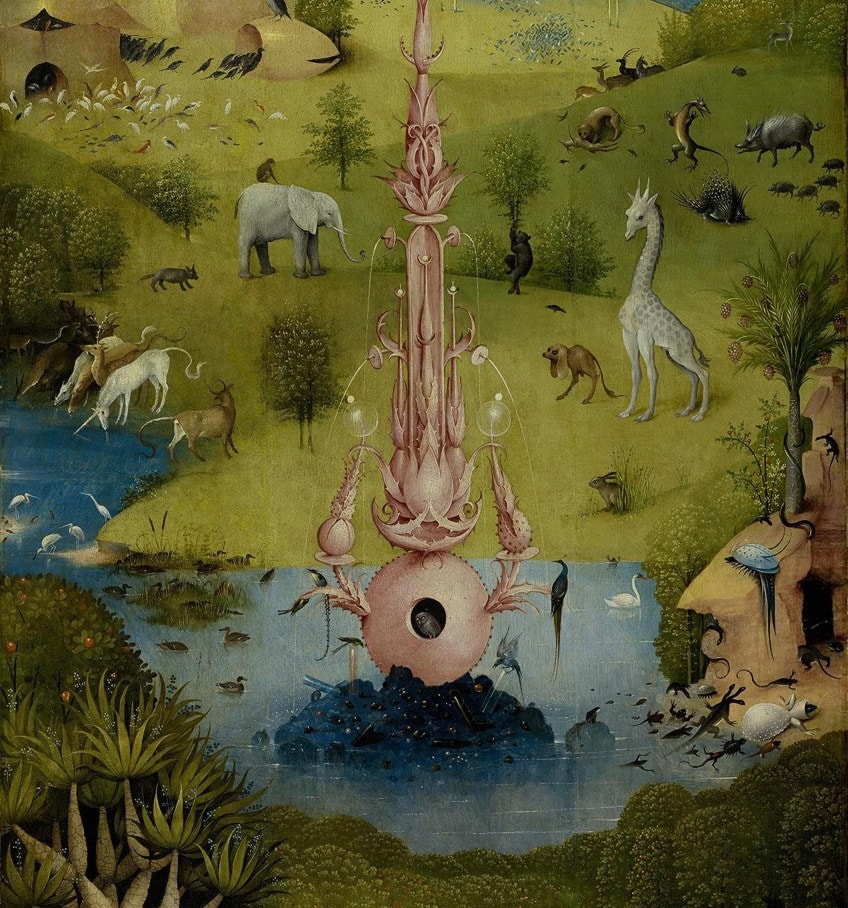 A detail of the inner left wing of The Garden of Earthly Delights (Paradise) by Hieronymus Bosc h, c. 1490-1510; Hieronymus Bosch, Public domain, via Wikimedia Commons
A detail of the inner left wing of The Garden of Earthly Delights (Paradise) by Hieronymus Bosc h, c. 1490-1510; Hieronymus Bosch, Public domain, via Wikimedia Commons
We see more creatures emerging from the water and walking onto the bank to the right.
And other animals like an elephant, a giraffe, birds, a rabbit, and animals that seem like a mix of buck and feline. There is also a white unicorn drinking from the water to the left and a two-legged creature that appears like a dog with floppy ears.
Towards the background, we notice a mountainous region again. There is a geometric stone-like structure to the left where a swarm of birds is emerging in a swift patterned flight. Bosch's stone structure appears quite organic and fits in with the environment around it. We see more geometric structures in the distance as part of the hill, especially the peculiar double disc-like form with a thick and large arc-shaped branch pierced into both as if keeping them in place.
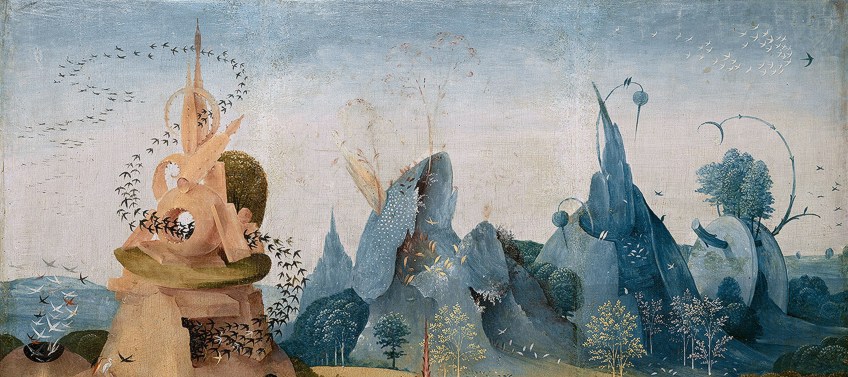 The mountainous regions of the inner left panel of The Garden of Earthly Delights (Paradise) by Hieronymus Bosc h, c. 1490-1510;Hieronymus Bosch, Nihiltres, CC0, via Wikimedia Commons
The mountainous regions of the inner left panel of The Garden of Earthly Delights (Paradise) by Hieronymus Bosc h, c. 1490-1510;Hieronymus Bosch, Nihiltres, CC0, via Wikimedia Commons
This first panel appears quite light-hearted in its ambiance, there does not seem to be anything too drastic happening, except for some animals catching their prey, which could be indicative of what is to come. Furthermore, what this scene symbolizes with Adam and Eve is the idea of fertility and procreation. We do not see blatant references to the traditional apple and snake motifs, but this does not take away the fact that sin is not present.
Let us now move on towards the central panel where the narrative is busier and more complex.
Center Panel – Garden of Earthly Delights
Here we enter the famous Garden of Earthly Delights, which is filled with hundreds of nude figures, some are European and some appear African. The landscape stretches out far into the distance with part of a lake towards the bottom left corner of the foreground, it also makes an upside-down "T" shape in the background where there are five peculiar pink (maybe stone?) and blue (maybe metal?) structures, just like the one we saw from panel one.
 The central panel of Hieronymus Bosch's The Garden of Earthly Delights (c. 1490-1510); Hieronymus Bosch, Public domain, via Wikimedia Commons
The central panel of Hieronymus Bosch's The Garden of Earthly Delights (c. 1490-1510); Hieronymus Bosch, Public domain, via Wikimedia Commons
The foreground is filled with figures all seemingly romping and cavorting with one another; some are eating and holding different types of berries, some are feeding each other, some are being fed by large birds, and some stand with large cherries on their heads. We will also notice some of these berries are extra-large, there is a figure holding an oversized fish too.
Everyone seems to be enjoying themselves in this garden. There is a mix of men and women, some women appear pregnant too.
 The foreground of the central panel of Hieronymus Bosch's The Garden of Earthly Delights (c. 1490-1510); Hieronymus Bosch, Public domain, via Wikimedia Commons
The foreground of the central panel of Hieronymus Bosch's The Garden of Earthly Delights (c. 1490-1510); Hieronymus Bosch, Public domain, via Wikimedia Commons
Towards the left we see a Caucasian man about to kiss an African woman, her right hand resting over her pregnant stomach. They are both sitting on a large Mallard duck with another large Kingfisher bird hitching a ride right at the back of the duck. Some figures also have flowers emerging from their rectums.
Just below the above-mentioned figures, we see a large owl half in the water with a greyish figure giving it what looks like a hug. Just in front of this scene we see two figures sitting in a transparent sphere, the man has his hand on the woman's womb area, but she does not appear pregnant – could she be pregnant?
The transparent sphere appears like a flower.
The couple sits inside what could be the main part of the flower, the receptacle leads into the main leafy stalk that is a light salmon color, this emerges from a small bulb-like structure, which has a hole at the far end of it and a man's face looking out of it, his fingers curling over the edge. A glass or crystal tube is fit into the hole with a mouse in the tube – the man inside appears to be looking at the mouse.
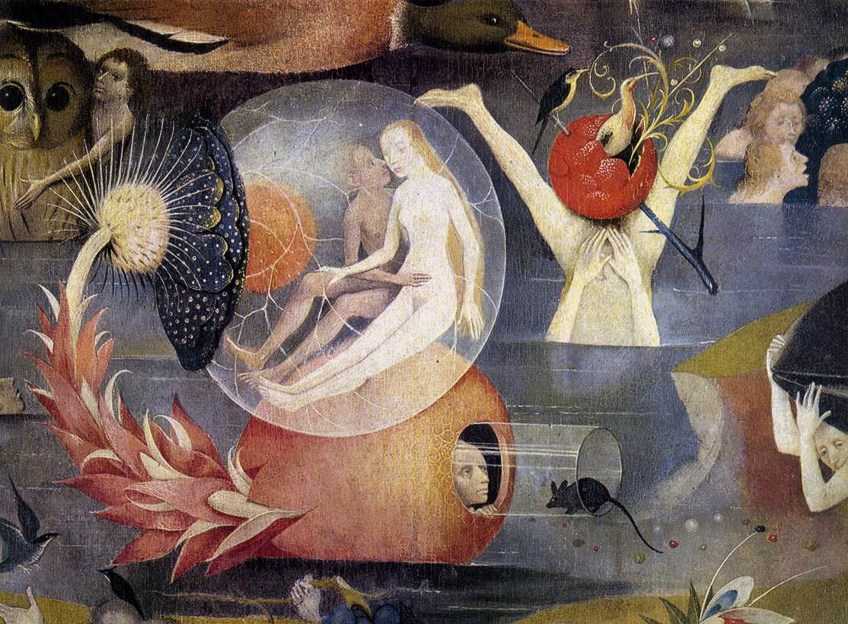 A detail of the central panel of Hieronymus Bosch's The Garden of Earthly Delights (c. 1490-1510); Hieronymus Bosch, Public domain, via Wikimedia Commons
A detail of the central panel of Hieronymus Bosch's The Garden of Earthly Delights (c. 1490-1510); Hieronymus Bosch, Public domain, via Wikimedia Commons
This structure is reminiscent of the process of conceiving and giving birth. Could the couple in the top spherical bulb be giving birth to the man in the bottom bulb who will seemingly be birthed through the tube while the leafy stalk acts like an umbilical cord? As with all these micro-narratives that Bosch painted, there are hundreds of interpretations open to us, but what seems apparent throughout is the theme of procreation and fertility.
Another interpretation of this spherical orb with the couple inside is related to the Flemish proverb, "Happiness is like glass, it soon breaks".
In the middle ground, we see a strip of land with a circular pool of water in the center. There are hundreds of men riding horses, cows, bears, and other hybrids of enlarged animals like a unicorn with a long horn that looks like a stag's antler. They all surround the central circular pool, in which we see mainly women of different races.
 Middleground of the central panel of Hieronymus Bosch's The Garden of Earthly Delights (c. 1490-1510); Hieronymus Bosch, Public domain, via Wikimedia Commons
Middleground of the central panel of Hieronymus Bosch's The Garden of Earthly Delights (c. 1490-1510); Hieronymus Bosch, Public domain, via Wikimedia Commons
If we move towards the background the five structures appear almost like amusement parks, the figures appear inside, outside, and around; everyone is having fun with one another. Some figures are also in the surrounding water. This is definitely a delight for everyone involved.
If we look closely there is a couple in the water, but the woman looks like a mermaid with a man appearing to embrace her; it is unclear if he is also a merman. Right in front of these two, we see a large white egg with the top cracked open and several figures climbing into it from the water.
 Background of the central panel of Hieronymus Bosch's The Garden of Earthly Delights (c. 1490-1510); Hieronymus Bosch, Public domain, via Wikimedia Commons
Background of the central panel of Hieronymus Bosch's The Garden of Earthly Delights (c. 1490-1510); Hieronymus Bosch, Public domain, via Wikimedia Commons
There is a sense of wild abandon here and an intermingling of humans and animals. It does not seem like the figures are cognizant of what they are doing – they are completely in the moment as if they are products of the natural world. Where is God in this narrative? Or are "Man" and "Woman" left to their own devices with each other?
This panel has also been described as a "false paradise" as the figures engage in sinful acts. This will inevitably lead to their demise, which we see in the next (right) panel.
Right Panel – Hell
Bosch does not hold back in his depiction of Hell. Depicted here is a dark night compared to the daylight scenes from the previous left and central panels. The scene runs along with the same layout as the previous panels: the foreground, middle ground, and background.
The figures who were seemingly oblivious to their follies beforehand are now completely aware and ensnared in their own forms of hellish torments.
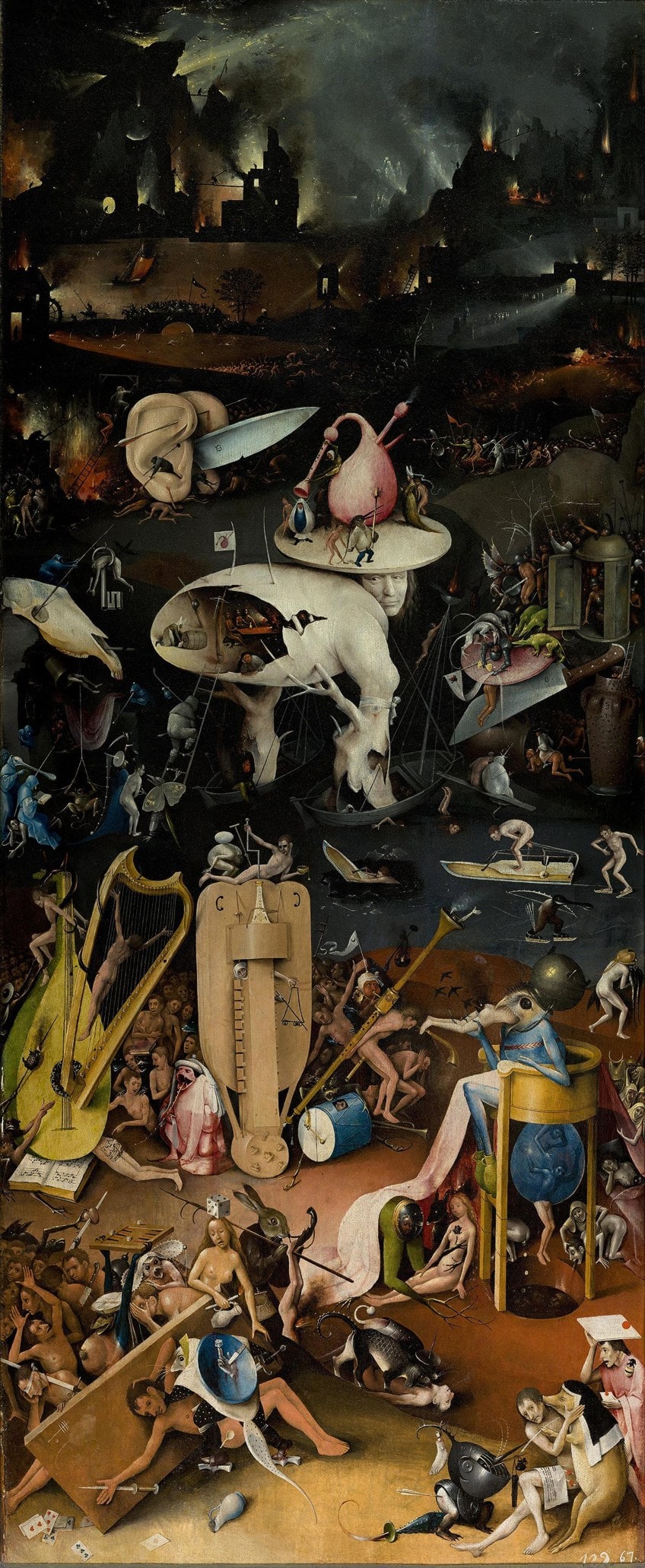 The inner right-wing panel of Hieronymus Bosch's The Garden of Earthly Delights (Hell) (c. 1490-1510);Hieronymus Bosch, Public domain, via Wikimedia Commons
The inner right-wing panel of Hieronymus Bosch's The Garden of Earthly Delights (Hell) (c. 1490-1510);Hieronymus Bosch, Public domain, via Wikimedia Commons
In the foreground, we see what looks like land with a frozen river just above it closer to the middle ground. The background is filled with torn-down buildings with ladders here and there. There are slivers of light from the windows and doors, some are rectangular, and others are circular, but we are given just enough light to see the clouds in the sky above.
There is the characteristic "Boschian" intermingling of humans, animals, and assortments of strange objects in strange places.
In the foreground, there are several musical instruments that seem to be instruments of torture now and not pleasure, ironically. There are also board games, dice, limbs, impaled figures, and figures being eaten by two dog-like creatures.
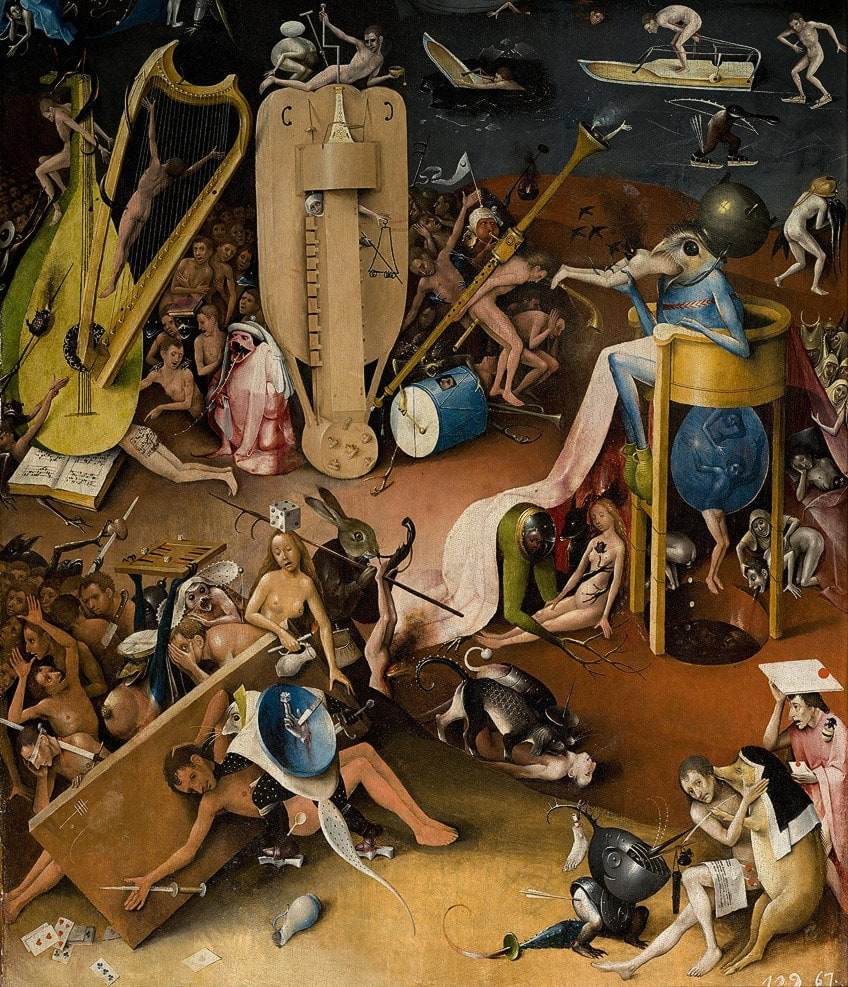 A detail of the inner right-wing panel of Hieronymus Bosch's The Garden of Earthly Delights (Hell) (c. 1490-1510); Hieronymus Bosch, Public domain, via Wikimedia Commons
A detail of the inner right-wing panel of Hieronymus Bosch's The Garden of Earthly Delights (Hell) (c. 1490-1510); Hieronymus Bosch, Public domain, via Wikimedia Commons
In the bottom right corner, there is a pig wearing part of a nun's habit, sniffing a man, almost on top of him. The man seems bothered and tries to push the pig away. Directly opposite these two is a man being impaled against an overturned table by a creature with armor on his back.
What is jarring about this armor, which really appears like a blue concave dish, is that it has a severed hand with a dagger through it, balancing a die on the index and middle fingers.
Further to the right side, we see a large blue creature, it looks like a bird and toad, sitting on a high golden chair with two jugs over its feet and what looks like a cauldron over its head as a hat. The creature is busy swallowing a human body, which appears to have swallows flying out of its rectum.
The bird-toad-like creature has a transparent blue bubble forming below its rectum with the human bodies coming out of it and falling directly into a small pool of human excrement. In the pool of cess-water, there are human faces, someone around the edge is vomiting into it, and on the other side, someone defecates coins into it.
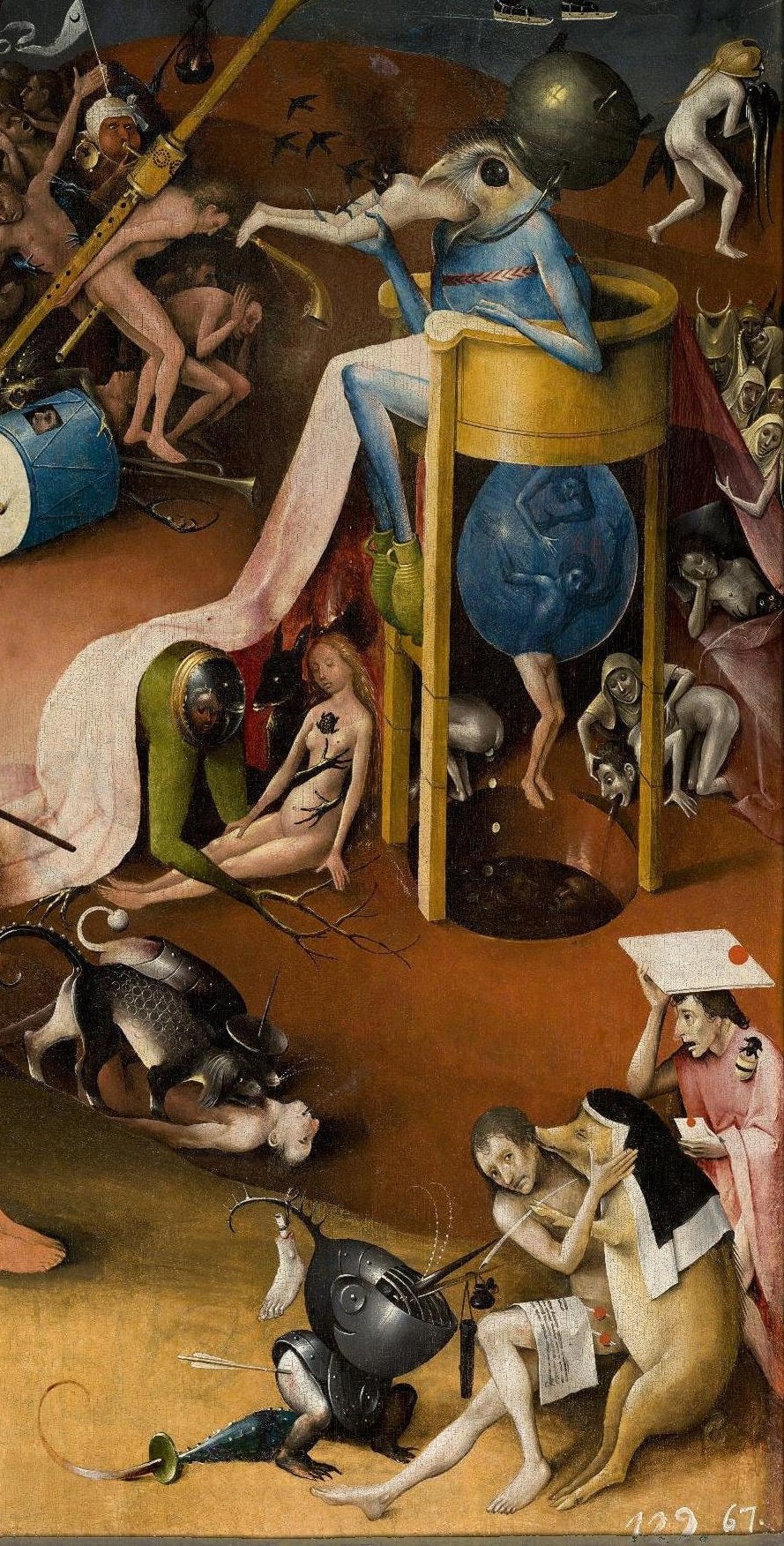 A detail of the inner right-wing panel of Hieronymus Bosch's The Garden of Earthly Delights (Hell) (c. 1490-1510); Hieronymus Bosch, Public domain, via Wikimedia Commons
A detail of the inner right-wing panel of Hieronymus Bosch's The Garden of Earthly Delights (Hell) (c. 1490-1510); Hieronymus Bosch, Public domain, via Wikimedia Commons
In the center of the middle ground, we see a large organic-type structure, there is a face of a man staring to his right (our left). An interesting fact about this face is that it is believed to be a self-portrait of the famous Bosch artist himself.
He has been referred to by some as the "Tree Man".
On top of this is a large, circular, flat plate with smaller objects and figures on it, notably a pink object that looks like an organ crossed with a musical instrument. A figure holds a pipe right on another figure as if to torture her or him with the sound.
This head appears to be lightly touching or ensconced next to the back end of what looks like a bony-like torso, the hooves or feet are in two boats on the river. Inside this open torso are figures sitting around a rectangular table. The figure by the end of the table sits on a frog. There is a figure staring out over the edge and another figure on her knees pouring something from a barrel. There is a ladder leading up to this open "cavern" and a greyish figure climbing up it with an arrow protruding from his rectum.
 A detail of the inner right-wing panel of Hieronymus Bosch's The Garden of Earthly Delights (Hell) (c. 1490-1510); Hieronymus Bosch, Public domain, via Wikimedia Commons
A detail of the inner right-wing panel of Hieronymus Bosch's The Garden of Earthly Delights (Hell) (c. 1490-1510); Hieronymus Bosch, Public domain, via Wikimedia Commons
The right panel depicts motifs related to the Seven Deadly Sins, some examples include the man vomiting, who symbolizes gluttony. The woman whose reflection we see in the mirror, on the backside of a green creature whose front part is covered, could symbolize vanity. The man defecating gold coins could symbolize greed.
Perspective and Scale
Throughout the three panels, there is a continuous horizon line connecting the entire narrative. In the Garden of Earthly Delights, Hieronymus Bosch created a large piece, scaling at more than seven feet in height. This adds considerable emphasis to the subject matter because Bosch painted hundreds of small figures and objects all fit into these large panels. This is also a testament to Bosch's skill as an artist and his keen eye for detail. Furthermore, Bosch's imagination also impacted the scale.
 The horizon of The Garden of Earthly Delights (c. 1490-1500) by Hieronymus Bosch;Hieronymus Bosch, Public domain, via Wikimedia Commons
The horizon of The Garden of Earthly Delights (c. 1490-1500) by Hieronymus Bosch;Hieronymus Bosch, Public domain, via Wikimedia Commons
He depicted various animals as not true to size, creating some as larger than humans making the humans appear small and almost child-like.
Bosch's fantastical depiction of size is a significant part of what makes his painting what it is. It is also what makes his other paintings unique too. We see elements of the play on size and scale in his other artworks, for example, The Last Judgment (c. 1495 to 1505), The Temptation of St. Anthony (c. 1500 to 1510), and The Haywain (1510 to 1516).
The Garden of Earthly Delights Meaning
There have been numerous ideas surrounding The Garden of Earthly Delights meaning and Bosch did not document his influences or inspirations related to this artwork. Although it holds significant religious meaning, there are theories Bosch also painted this for a select, if not elite, group of people who would have understood many references.
Furthermore, it could be that Bosch also drew from esoteric and mystical sources. The Humanist movement we mentioned earlier could have been a large influencing factor because it would have brought new knowledge to the surface of societal groups.
 The Garden of Earthly Delights (c. 1490-1500) by Hieronymus Bosch at the Museo del Prado in Madrid; Hieronymus Bosch, Public domain, via Wikimedia Commons
The Garden of Earthly Delights (c. 1490-1500) by Hieronymus Bosch at the Museo del Prado in Madrid; Hieronymus Bosch, Public domain, via Wikimedia Commons
Apparently, during these times there was also knowledge of the lost city of Atlantis, which would have undoubtedly been read from the ancient Classical texts that many Renaissance scholars revisited, for example, the dialogue Critias (c. 360 BCE) by the ancient Greek philosopher Plato.
This touches on the concept of a utopian world too, which is not too far-fetched when applied to Bosch's triptych and the strange structures and paradisiacal landscape we see in the left and central panels.
As the Renaissance was a time of new knowledge and "Rebirth" it was ultimately all about discovery. There were many discoveries that led explorers beyond Europe and into other countries like Asia, Africa, and India. Sources also suggest that Bosch drew inspiration from Cyriacus of Ancona, an Italian explorer and early pioneer of archaeology.
Forever a Garden of Delight
The Garden of Earthly Delights has become a delight for thousands of art enthusiasts. If we look at it in the 21st century it is a pop-cultural phenomenon and the strange creatures we have come to know have become almost endearing in their strangeness. For example, the sculptor Roberto Benavidez, who is from Texas, created his Piñatas of Earthly Delights based on some of the animals from Bosch's painting – here the artist introduces us to life-sized versions, bringing to life Bosch's Garden.
However, it has not only been life-size sculptures but video animations. For example, the MOTI Museum located in Holland created a video installation with a modern twist. The Boschian creatures from the triptych became 21st-century items and actions – asking the important question, how different was Bosch's triptych to how our lives are today? Maybe the painting is still a reminder for us about excess and desire, and us, humans, being consumed by it?
While there are many more sources that would point to what inspired Bosch's triptych this is one painting that has remained a mystery since its creation. We have moved from day to night, from God to Hell, and from pleasure to pain. Hieronymus Bosch has certainly created a masterpiece of art open to all of us to decide what it means, yet the meaning is right in front of us.
Frequently Asked Questions
Who Painted The Garden of Earthly Delights?
The Garden of Earthly Delights was painted as a triptych by the Northern Renaissance artist Hieronymus Bosch around 1480 to 1505.
What Do The Garden of Earthly Delights Panels Show?
In The Garden of Earthly Delights (c. 1480 to 1505) Hieronymus Bosch depicts three panels that focus on the concepts of lust, sinfulness, and morality. The panels start from left to right. The left panel depicts The Garden of Eden where God introduces Adam and Eve; the central panel depicts the famous Garden of Earthly Delights, where there is a sense of exploration of sexuality and sensuality among men and women. The last, or right panel, depicts Hell, which shows men and women tortured by animal-like and demon-like creatures.
Where Is The Garden of Earthly Delights Housed?
The Garden of Earthly Delights (c. 1480 to 1505) is housed in the Prado Museum (Museo del Prado) located in Madrid, Spain. It has been in the Prado Museum since 1939.
What Is The Garden of Earthly Delights Meaning?
There have been numerous theories around Hieronymus Bosch's The Garden of Earthly Delights (c. 1480 to 1505) triptych. Some believed it is about the fall of man into sin and lust, eventually meeting his own fate in Hell. Some believe it was painted for religious and moralistic purposes. Other sources suggest it was painted to personify various proverbs and, in this way, visually portray a moral message. There are religious and esoteric interpretations, however, its meaning remains one of the most elusive in art history.
Where Was The Garden Of Earthly Delights Painted
Source: https://artincontext.org/the-garden-of-earthly-delights-hieronymus-bosch/
Posted by: rooneyadefees.blogspot.com

0 Response to "Where Was The Garden Of Earthly Delights Painted"
Post a Comment